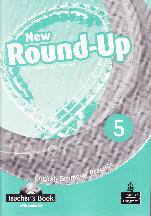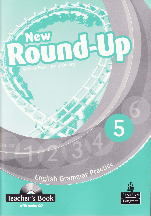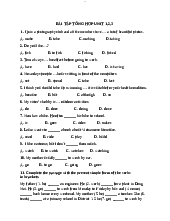








Preview text:
LESSON PLAN
TOPIC 4. FLORA AND FAUNA
LESSON 13. SOME PARTS OF PLANTS I. AIMS 1. Knowledge
- Plant classification is based on a number of criteria (e.g. characteristics of
how the stem grows, shape of the roots, shape or color of leaves)
- Comparable (shape, size, color,...) roots, stems, leaves, flowers, fruits of different plants. 2. Ability
a. General Competencies:
- Autonomy and self-learning: know how to listen and share personal opinions
with you, the team and the TEACHER. Actively participate in class activities.
- Communication and cooperation: have the habit of exchanging and helping
each other in learning; know how to complete learning tasks together under the guidance of teachers.
- Problem solving and creativity: know how to coordinate with friends when
working in groups, be creative when participating in technology activities.
b. Natural Social Capacity:
- Socio-natural cognitive capacity: Draw or use existing diagrams to show the
location and speak (or write) the names of certain parts of plants.
- Capacity for natural social use: Classify plants based on a number of
criteria (e.g., characteristics of how stems grow, shape of roots, shape or
color of leaves). Comparable (shape, size, color,...) roots, stems, leaves,
flowers, fruits of different plants. 3.
Qualities: Love, know a lot about plant parts. II. PREPARE 1. For teachers
- Lesson Plans, TEACHER Books Social Nature 3, Social Nature 3.
- Pictures of at least 10 familiar local trees clearly see the stems, roots, and
leaves of the tree. Or some real plants are around the classroom, which have
different characteristics of stems, roots, leaves.
- Picture Study Voucher Form 59 (in groups) 2. For students - Social Natural SGK 3.
- Pictures of some real plants or trees, real leaves to observe (according to the content of each lesson).
- Group or large paper or the back of a calendar to record the surrounding
plants (Suggested by SGK page 59) III. PROCEDURE TEACHER ACTIVITIES STUDENT ACTIVITIES A. STARTUP OPERATION
- STUDENTS are excited to participate in the game
a. Objective: Create excitement for
STUDENTS, step by step familiarize themselves with the lesson.
- STUDENTS receive papers, discuss b. How it works and register
- TEACHERS organize STUDENTS to
play the game "Plants Around Us"
- TEACHER disseminates the rules:
The TEACHER divides the class into
small groups, gives the STUDENTS A0
paper and asks the group members to
write down the names of surrounding - STUDENTS exchange and share
plants that they know. The group that answers:
scores the most and is accurate will be commended. - The TEACHER commented on the
teamwork, asked suggestive questions
in the classroom and called several - STUDENTS listen and absorb
STUDENTS to answer: There are
many different trees around us. Which plants do you like? Why?
- STUDENTS observe, discuss, choose
- TEACHER comments, reviews and their favorite plants and describe:
conclusions: Nature has endowed man + The areca tree is very tall, the stem
with a lot of things, one of which is is straight
plants. Coming to the first lesson in
this topic, we will learn together some + Long-leaved kohlrabi
of the fates of plants so that we have
more useful and fascinating + Mango trees have many fruits
knowledge. Let's find out in today's
lesson – Lesson 13. Some parts of
+ Hemlock plant with red leaves plants B. KNOWLEDGE FORMATION ACTIVITIES
Activity 1: Introduce the name of the
tree and its distinguishing features
a. Objective: STUDENTS can identify
and introduce the name of the tree and - STUDENTS group up to present, its outstanding features. other groups add. b. How to proceed - STUDENTS listen and absorb - The TEACHER asks STUDENTS to
read the lead sentence of the activity,
observe Figure 1 in groups (2-4
STUDENTS) select some trees in the
picture (or trees in reality that - STUDENTS observe and exchange
STUDENTS know) and follow the answers to questions:
requirements of the activity: Which + Pile roots: there are many baby
trees are you observing in the
picture? State the characteristics of roots that grow obliquely, from the some trees in the picture?
baby roots grow more small roots.
- TEACHERS invite representatives of + Cluster roots: consists of many
some groups of STUDENTS to nearly equal length subroots forming a
introduce the name of the tree, the bunch.
outstanding features of that tree. - TEACHERS help STUDENTS draw
comments through the presentation: - STUDENTS groups present, other
Plants are very diverse, different plants groups listen and complement
have different characteristics.
- STUDENTS listen and remember.
Activity 2: Name and describe the
characteristics of the roots - STUDENTS observe and absorb.
a. Objectives: STUDENTS are happy,
active, observe paintings and real
objects, speak the name of the groom - STUDENTS think and name.
and describe it đặc điểm của rễ cây đó với bạn. b. How to proceed - STUDENTS observe, discuss in
- The TEACHER asks STUDENTS to groups and respond: read the question, observe the
information in Figure 2 (picture of two + Group 1 (figure 3): Amaranth plants
types of roots) and observe the real – stake roots.
object so that STUDENTS can say the
name of each type of root, comment on + Group 2 (figure 4): Celery plants –
the characteristics of the shape of each cluster roots. of them.
+ Group 3 (figure 5): Rice plants –
- The TEACHER calls representatives cluster roots.
of several groups of STUDENTS to
comment and describe two different + Group 4 (figure 6): Grapefruit tree – types of roots. stake root.
- TEACHER Knowledge: There are - STUDENTS groups report results,
two main types: stake roots and beam
other groups listen and supplement. roots.
- STUDENTS are excited to participate
- TEACHER introduces some locally in the game.
familiar trees with stake and bunch roots.
- The TEACHER asks the STUDENTS
to add some plants of pile and cluster roots that they know
- STUDENTS think, name it in turn. C. PRACTICAL ACTIVITIES
a. Objectives: STUDENTS identify, - STUDENTS listen and absorb
name, type of root and describe its characteristics. - STUDENTS observe and answer b. How to proceed questions:
- The TEACHER divides the class into
4 groups, asking STUDENTS to + Trees with erect stems: jackfruit
observe figures 3 to 6 so that it names trees, rice trees
the tree and the root type of that tree Creeping plants: melon plants
corresponds to the assigned figure.
Cow stem plants: watermelon plants. - TEACHERS ask group
representatives to report results.
+ Woody plants: jackfruit tree
- TEACHERS organize students to Herbaceous plants: rice plants, melon
play the game "Agility Test".
plants, watermelon plants.
- TEACHER disseminates the rules of
the game: The TEACHER divides the
class into 2 ranges: row 1 is the pile root, row 2 is the beam root.
STUDENTS in two rows took turns
naming a plant of the stake/cluster root
to which the child was assigned. The
sequence that fails to answer by the
end loses, and the winning sequence is commended. - TEACHERS praise the team's performance C. KNOWLEDGE FORMATION ACTIVITIES
Activity 1: Speak the name of the
tree and describe the characteristics of the trunk.
a. Objective: STUDENTS can identify
and introduce the name of the tree and its outstanding features. b. How to proceed - The TEACHER asks STUDENTS to
work individually to read the activity
requirements and observe figures 7 to - STUDENTS listen and absorb 10 in the SGK and answer the question:
+ Name the plants you see?
+ Which tree has a standing stem, - STUDENTS respond, other
creeping stem, cow trunk? STUDENTS listen, add
+ Which plants have woody and herbaceous?
- The TEACHER comments and closes the correct answer. - STUDENTS observe and draw characteristics Activity 2: Comment on the
characteristics of the tree shape Listen and absorb
a. Objective: STUDENTS are happy,
positive, choose the tree they like to
observe and describe some features of
that tree to you, say the name of the
tree, the characteristics of their trunk. b. How to proceed
- The TEACHER asks STUDENTS to - STUDENTS share the results of
carefully observe and comment on the observations.
characteristics of the trees together
(e.g. size, shape, growing style,
hardness, softness,...) and hints for
STUDENTS to recall some familiar
local tree trunks, observe real objects
to feel the characteristics of the woody trunk, herbaceous plants. - The TEACHER asks STUDENTS to
share the results of observations, make
(simple) comments about the shape
(tall, large, small, low, long,...),
growing style (straight, creeping
clinging to the trunk or other object,
lying, reptile to the ground,...);
hardness, with the addition of branches
(woody), sedge (herbaceous) stem tubers.
- TEACHER Knowledge: Plants with
standing stems, creeping stems, cow
stems. There are woody types such as
jackfruit, mango,... and there are
herbaceous types such as rice, beans, watermelons,... - The INSTRUCTOR reads the Did
you know section to learn how to
expand some of the deformed parts of
the tree and encourage STUDENTS to
take more examples of some plants with deformed stems and roots. D. PRACTICAL ACTIVITIES
a. Objectives: STUDENTS voluntarily
perform the task, observe their
surroundings, ask for the name of the
tree and write the appropriate tree
name according to the classification
boxes of erect trunks, cow trunks, creeping trunks. b. How to proceed: - The TEACHER asks STUDENTS to
observe pictures of familiar local trees - STUDENTS listen and remember
or actual trees around the classroom (if
possible) and record tree names,
categorizing them according to stem
characteristics (encourage groups to
record more than 2 trees in each cell)
- STUDENTS read and take examples
- The TEACHER covers and guides
STUDENTS to observe the reality
(depending on the conditions of the organization) - STUDENTS observe prepared
paintings and record tree names,
- The TEACHER organizes for categorizing them
STUDENTS to report the results of
observations in groups and in front of the class, commending those
STUDENTS who have scored the most - STUDENTS listen and absorb
tree names and accurate classifications. * REINFORCE, INSTRUCT - STUDENTS listen attentively
- The TEACHER summarizes the core knowledge of the lesson. - STUDENTS listen and remember - The TEACHER reminds each
STUDENT to prepare to bring to class
after 2 leaves of the same shape and size.
- STUDENTS listen, remember and take on tasks




